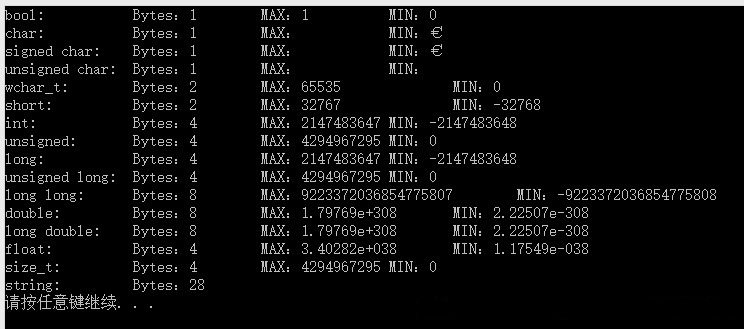编程题目: PAT 1011. A+B和C (15)
2014-07-02 13:51
381 查看
1011. A+B和C (15)
时间限制50 ms
内存限制
32000 kB
代码长度限制
8000 B
判题程序
Standard
作者
HOU, Qiming
给定区间[-231, 231]内的3个整数A、B和C,请判断A+B是否大于C。
输入格式:
输入第1行给出正整数T(<=10),是测试用例的个数。随后给出T组测试用例,每组占一行,顺序给出A、B和C。整数间以空格分隔。
输出格式:
对每组测试用例,在一行中输出“Case #X: true”如果A+B>C,否则输出“Case #X: false”,其中X是测试用例的编号(从1开始)。
输入样例:
4 1 2 3 2 3 4 2147483647 0 2147483646 0 -2147483648 -2147483647
输出样例:
Case #1: false Case #2: true Case #3: true Case #4: false
本题乍一看,简单的让人难过!稍微仔细看一下,考察的点应该就在于数的范围给的比较大,这样随之而来的可能会有A+B的溢出问题,所以单纯的用int型应该是不合适的,考虑用long int,或long long int ,经过试验long int是可行的。
/* http://pat.zju.edu.cn/contests/pat-b-practise/1011 */ #include<iostream> #include<vector> using namespace std; int main() { int num; long int a,b,c; cin>>num; vector<int> flag(10); int i; for(i =0;i<num;i++) { cin>>a>>b>>c; flag[i]= a+b>c ? 1:0; } for(i=0;i<num;i++) { cout<<"Case #"<<i+1<<": "; if(flag[i]) cout<<"true"<<endl; else cout<<"false"<<endl; } system("pause"); return 0; }
另外,在看了别人的阶梯办法之后,这里因引入一下,针对AB的符号分别进行分析,贴一下转载的代码。
//PAT1011
//这题就是死磕自己....
//考虑a,b同号溢出问题,若同号转a > c - b, 异号直接相加判断
#include <iostream>
using namespace std;
inline bool isSame(int a, int b)
{
return ( a > 0 && b > 0 ) || ( a < 0 && b < 0 );
}
int main()
{
int a, b, c;
int t;
int cnt = 1;
cin>>t;
while ( cnt <= t )
{
cin>>a>>b>>c;
bool flag = false;
if ( isSame(a, b) ) //若a,b同号
{
if ( a > 0 )
{
if ( c > 0 ) //a, b, c > 0
flag = ( a > (c - b) ); //a + b > c 转为 a>(c -b )
else //a, b > 0, c <= 0, 结果必为真
flag = true;
}
else
{
if ( c < 0 ) //同上,a,b,c < 0
flag = ( a > (c - b) );
else //同上a, b < 0, c >= 0, 结果必为真
flag = false;
}
}
else //a,b异号
flag = ( a + b > c );
if ( flag )
{
cout<<"Case #"<<cnt++<<": true"<<endl;
}
else
{
cout<<"Case #"<<cnt++<<": false"<<endl;
}
}
return 0;
}另外,作为延伸,贴一下C++中各个数据类型所占的空间大小以及所能表示的数的范围。获得以下结果的代码一同给出(非原创)。

#include<iostream>
#include<string>
#include <limits>
using namespace std;
int main()
{
cout << "bool: \t\t" << "Bytes:" << sizeof(bool);
cout << "\tMAX:" << (numeric_limits<bool>::max)();
cout << "\t\tMIN:" << (numeric_limits<bool>::min)() << endl;
cout << "char: \t\t" << "Bytes:" << sizeof(char);
cout << "\tMAX:" << (numeric_limits<char>::max)();
cout << "\t\tMIN:" << (numeric_limits<char>::min)() << endl;
cout << "signed char: \t" << "Bytes:" << sizeof(signed char);
cout << "\tMAX:" << (numeric_limits<signed char>::max)();
cout << "\t\tMIN:" << (numeric_limits<signed char>::min)() << endl;
cout << "unsigned char: \t" << "Bytes:" << sizeof(unsigned char);
cout << "\tMAX:" << (numeric_limits<unsigned char>::max)();
cout << "\t\tMIN:" << (numeric_limits<unsigned char>::min)() << endl;
cout << "wchar_t: \t" << "Bytes:" << sizeof(wchar_t);
cout << "\tMAX:" << (numeric_limits<wchar_t>::max)();
cout << "\t\tMIN:" << (numeric_limits<wchar_t>::min)() << endl;
cout << "short: \t\t" << "Bytes:" << sizeof(short);
cout << "\tMAX:" << (numeric_limits<short>::max)();
cout << "\t\tMIN:" << (numeric_limits<short>::min)() << endl;
cout << "int: \t\t" << "Bytes:" << sizeof(int);
cout << "\tMAX:" << (numeric_limits<int>::max)();
cout << "\tMIN:" << (numeric_limits<int>::min)() << endl;
cout << "unsigned: \t" << "Bytes:" << sizeof(unsigned);
cout << "\tMAX:" << (numeric_limits<unsigned>::max)();
cout << "\tMIN:" << (numeric_limits<unsigned>::min)() << endl;
cout << "long: \t\t" << "Bytes:" << sizeof(long);
cout << "\tMAX:" << (numeric_limits<long>::max)();
cout << "\tMIN:" << (numeric_limits<long>::min)() << endl;
cout << "unsigned long: \t" << "Bytes:" << sizeof(unsigned long);
cout << "\tMAX:" << (numeric_limits<unsigned long>::max)();
cout << "\tMIN:" << (numeric_limits<unsigned long>::min)() << endl;
cout << "long long: \t" << "Bytes:" << sizeof(long long);
cout << "\tMAX:" << (numeric_limits<long long>::max)();
cout << "\tMIN:" << (numeric_limits<long long>::min)() << endl;
cout << "double: \t" << "Bytes:" << sizeof(double);
cout << "\tMAX:" << (numeric_limits<double>::max)();
cout << "\tMIN:" << (numeric_limits<double>::min)() << endl;
cout << "long double: \t" << "Bytes:" << sizeof(long double);
cout << "\tMAX:" << (numeric_limits<long double>::max)();
cout << "\tMIN:" << (numeric_limits<long double>::min)() << endl;
cout << "float: \t\t" << "Bytes:" << sizeof(float);
cout << "\tMAX:" << (numeric_limits<float>::max)();
cout << "\tMIN:" << (numeric_limits<float>::min)() << endl;
cout << "size_t: \t" << "Bytes:" << sizeof(size_t);
cout << "\tMAX:" << (numeric_limits<size_t>::max)();
cout << "\tMIN:" << (numeric_limits<size_t>::min)() << endl;
cout << "string: \t" << "Bytes:" << sizeof(string) << endl;
system("pause");
return 0;
}
相关文章推荐
- 编程题目: PAT 1011. A+B和C (15)
- 编程题目: PAT 1021. 个位数统计 (15)
- 编程题目: PAT 1001. 害死人不偿命的(3n+1)猜想 (15)
- 编程题目: PAT 1021. 个位数统计 (15)
- 编程题目: PAT 1001. 害死人不偿命的(3n+1)猜想 (15)
- 编程题目:PAT 1006. 换个格式输出整数 (15)
- 编程题目:PAT 1006. 换个格式输出整数 (15)
- 编程题目: PAT 1016. 部分A+B (15)
- 编程题目: PAT 1016. 部分A+B (15)
- 编程题目: PAT 1017. A除以B (20)
- 编程题目:PAT 1005. 继续(3n+1)猜想 (25)
- 编程题目:PAT 1007. 素数对猜想 (20)
- 编程题目: PAT 1010. 一元多项式求导 (25)
- PAT - 1011. A+B和C (15)
- 编程题目: PAT 1014. 福尔摩斯的约会 (20)
- 编程题目: PAT 1015. 德才论 (25)
- 编程题目: PAT 1012. 数字分类 (20)
- 编程题目:PAT 1005. 继续(3n+1)猜想 (25)
- 编程题目: PAT 1012. 数字分类 (20)
- PAT Basic Level 1011. A+B和C(15)
